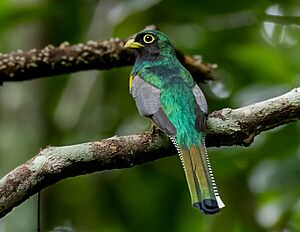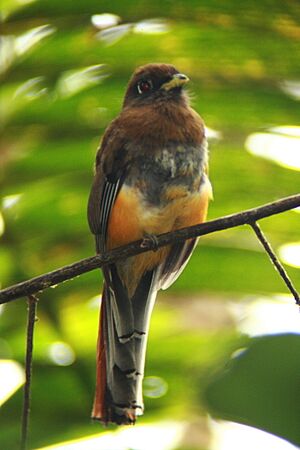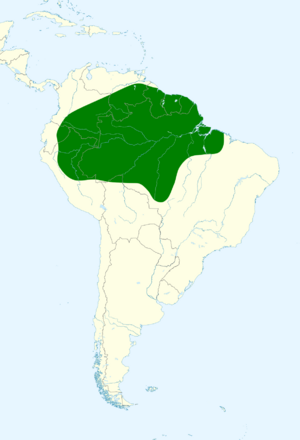Amazonian black-throated trogon facts for kids
Quick facts for kids Amazonian black-throated trogon |
|
|---|---|
 |
|
| Adult male in Manacapuru, Amazonas, Brazil | |
 |
|
| Conservation status | |
| Scientific classification | |
| Genus: |
Trogon
|
| Species: |
rufus
|
 |
|
The Amazonian black-throated trogon (Trogon rufus) is a beautiful bird. It belongs to the trogon family, called Trogonidae. You might also hear it called the "yellow-bellied trogon." But watch out, it's not the only trogon with a yellow belly! These birds live and breed in the lowlands of the Amazonia region.
Contents
About the Amazonian Trogon
Naming the Bird
The Amazonian black-throated trogon was first officially described in 1788. A German scientist named Johann Friedrich Gmelin gave it its scientific name. He put it in the group of birds called Trogon. Its full scientific name is Trogon rufus. The word rufus is Latin for "red" or "ruddy."
Before Gmelin, a French expert named Comte de Buffon had described and drawn this bird in 1779. He called it the "Couroucou à queue rousse de Cayenne." Buffon's bird was a female with brown feathers. It was found in Cayenne.
Different Types of Trogons
Scientists recognize three main types, or subspecies, of the Amazonian black-throated trogon:
- T. r. rufus: Found in eastern Venezuela, the Guianas, and northern Brazil.
- T. r. sulphureus: Lives in southeastern Colombia, eastern Ecuador, northeastern Peru, and western Brazil.
- T. r. amazonicus: Found in northeastern Brazil.
Other similar trogon species were once thought to be the same as the Amazonian black-throated trogon. But now, they are considered separate species. These include the Atlantic black-throated trogon, the Northern black-throated trogon, and the Choco black-throated trogon.
What Does it Look Like?
Like most trogons, this bird has soft, colorful feathers. The males and females look quite different. This is a fairly small bird. It is about 23–24 centimeters (9-9.5 inches) long. It weighs around 54-57 grams (about 2 ounces).
Male vs. Female
- Males have a bright green head, upper chest, and back. Their face and throat are black. Their belly is a golden yellow.
- Females have a brown head, upper chest, and back. Their upper tail is a reddish-brown color. Their belly is yellow, just like the males.
Both males and females have a white underside of their tail with black stripes. They also have a yellow beak. Their wing feathers look gray from a distance. But up close, you can see tiny black and white lines on them.
Young Birds
Young trogons look like the adults, but their colors are not as bright. Young males have a brown throat, chest, and wing feathers.
Sounds They Make
The Amazonian black-throated trogon makes a churring sound, like krrrrrr. Their song is a series of clear whistles, often sounding like cuh cuh cuh cuh.
Where They Live and Their Home
These birds live in the lower parts of wet tropical forests. They like to stay in the deep shade of the forest floor. Their wide beaks and weak legs show what they eat and how they live in trees. Even though they can fly fast, they usually don't fly very far. They often perch upright and stay very still.
How They Live
What They Eat
Amazonian black-throated trogons mainly eat arthropods. These are creatures like insects and spiders. They also eat some fruit. They often catch their food while flying. They are one of the trogon species that eats the most insects. They are smart hunters! They sometimes catch insects that have been scared by other animals. For example, they might follow coatis (Nasua species). Coatis are like raccoons. When coatis move through the forest, they can scare up insects. The trogons then quickly grab them.
Nesting Habits
The black-throated trogon builds its nest in a shallow hole. These nests are usually found about 1 to 6 meters (3 to 20 feet) high. They don't line their nests with anything. A typical nest will have two white eggs.
See also
Black-throated trogon (disambiguation)
Sources
- de Mello Beisiegel, Beatriz (2007): Foraging Association between Coatis (Nasua nasua) and Birds of the Atlantic Forest, Brazil. Biotropica 39(2): 283–285 [English with Portuguese abstract]. (HTML abstract)
- Hilty, Steven L. (2003): Birds of Venezuela. Christopher Helm, London. ISBN: 0-7136-6418-5
- Pizo, Marco Aurélio (2007): The relative contribution of fruits and arthropods to the diet of three trogon species (Aves, Trogonidae) in the Brazilian Atlantic Forest. Revista Brasileira de Zoologia 24(2): 515-517 [English with Portuguese abstract]. PDF fulltext
- Stiles, F. Gary & Skutch, Alexander Frank (1989): A guide to the birds of Costa Rica. Comistock, Ithaca. ISBN: 0-8014-9600-4


